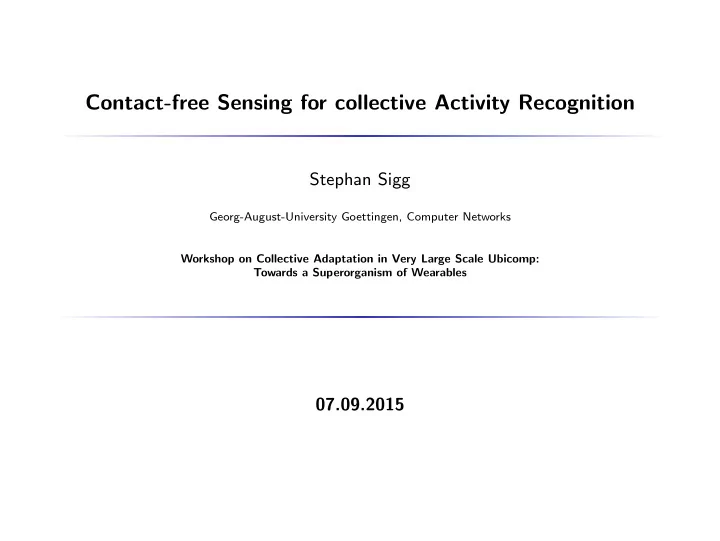

Contact-free Sensing for collective Activity Recognition Stephan Sigg Georg-August-University Goettingen, Computer Networks Workshop on Collective Adaptation in Very Large Scale Ubicomp: Towards a Superorganism of Wearables 07.09.2015
A superorganism of Wearables
A superorganism of Wearables
A superorganism of Wearables
A superorganism of Wearables
A superorganism of Wearables
A superorganism of Wearables
Social Centric Networking
Social Centric Networking
Social Centric Networking
Device-Free RF-based Activity Recognition
Device-Free RF-based Activity Recognition
Device-Free RF-based Activity Recognition
Device-Free RF-based Activity Recognition mobile phone within arms reach only 54% of the time A. K. Dey et al.: ’Getting closer: An empirical investigation of the proximity of user to their smart phones’ Ubicomp 2011 S. N. Patel et al.: ’Farther than you may think: An empirical investigation of the proximity of users to their mobile phones’ Ubicomp 2006
Using Fluctuation of electromagnetic waves at a receiver to recognise activities Scholz, Sigg, Shihskova, von Zengen, Bagshik, Guenther, Beigl, Ji: SenseWaves: Radiowaves for context recognition, in Video Proceedings of Pervasive 2011
RF-based device-free activity recognition g n g Crawling n i i d k n a l t a S W empty L y i n g
RF-based device-free activity recognition g n g Crawling n i i d k n a l t a S W empty L y i n g
Recent related work . Whole-Home Gesture Recognition Using Wireless Signals, Q. Pu, S. Gupta, S. Gollakota, S. Patel, Mobicom’13 See Through Walls with Wi-Fi!, F Adib, D. Katabi, SIGCOMM’13
Situation and gestures from passive RSSI-based DFAR 10cm 10cm Away Hold over Open/close Take up Towards Swipe Swipe Swipe Swipe Wipe No right bottom top left gesture
Situation and gestures from passive RSSI-based DFAR 10cm 10cm Away Hold over Open/close Take up Towards Swipe Swipe Swipe Swipe Wipe No right bottom top left gesture
Which sample rate can we expect? University (ETH) Train station P a c k e t s / s e c P a c k e t s / s e c ground 3 r d fl . 1 10.45 2 9.18 1 34.06 14.88 3 9.01 2 0.61 5.02 channel 4 21.91 3 4.45 0.19 channel 4 0.10 5 23.70 0.04 6 22.31 5 53.97 192.29 7 21.34 6 0.14 0.04 8 21.58 7 0.28 0.03 0.55 8 0.11 0.07 9 9 10 0.62 26.46 2.88 11 14.51 10 0.06 0.09 11 0.05 0.02 Café in center Dormitory P a c k e t s / s e c P a c k e t s / s e c 1 15.29 2 8.86 1 10.28 3 11.06 2 10.03 channel 4 1.41 3 12.13 channel 5 2.15 4 9.92 6 10.99 5 9.30 7 4.45 6 1.77 8 1.23 7 0.09 9 11.09 8 0.19 10 10.79 9 6.92 11 23.30 10 0.47 11 0.36 Suburban fl at P a c k e t s / s e c 1 0.85 2 0.35 3 0.32 channel 4 0.20 5 0.85 6 3.10 7 2.59 8 11.85 9 4.46 10 2.05 11 9.61
Sensing and recognition
Envisioned paradigm shift in mobile computing Parasitic operation Communication virtually for free Miniaturisation Processing & storage capabil. limited (passive, parasitic, backscatter)
Envisioned paradigm shift in mobile computing Parasitic operation Communication virtually for free Miniaturisation Processing & storage capabil. limited (passive, parasitic, backscatter) Trade processing load for communication load Shift computation towards the wireless communication channel Computation below computational complexity possible?
Calculation during transmission on the wireless channel Utilising Poisson-distributed burst-sequences transmit burst sequences . . . . . . . . . . . . . . . . . . . . . . . . . . . burst . . . . . . . . . . . . . . . . . . time superimposed received burst sequence . . . . . . . . . . . . t K Basic operations Addition, subtraction, division and multiplication at the time of wireless data transmission via Poisson-distributed burst-sequences
Calculation during transmission on the wireless channel Case study to compare the calculation accuracy Utilise data from the Intel Berkeley laboratory network (here: temperature) 1 Transmission of data by simple sensor nodes 2 3 1http://db.csail.mit.edu/labdata/labdata.html 2Sigg et al.: Utilising convolutions of random functions to realise function calculation via a physical channel, SPAWC’2013 3Sigg et al.: Calculation of functions on the RF-channel for IoT, IoT’2012
Calculation during transmission on the wireless channel Online Offline Online Offline
Mobile Crowdsourcing – Big Data – Smart City
Probabilistic graphical models Conditional random fields Distinguishing between observed variables X and target variables Y , in the unnormalized measure � P [ X , Y ] = φ C ( X C ) C we can define a conditional random field as 1 � P [ Y | X ] = φ C ( X C ) Z ( X ) C � Z ( X ) = P [ X , Y ] X
Application recommendation utilising Large-scale trends 832,236 devices Android + IOS 2012 - today http://carat.cs.helsinki.fi/
Application recommendation utilising trends
Application recommendation utilising trends
Application recommendation utilising trends
Application recommendation utilising trends
Recommend
More recommend